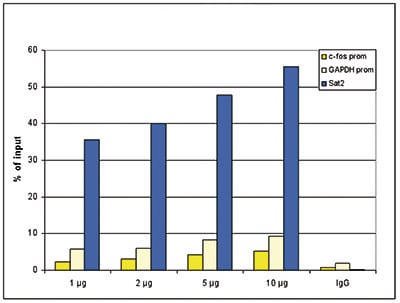Anti-Histone H4 (tri methyl K20) antibody - ChIP Grade (ab195479)
Key features and details
- Rabbit polyclonal to Histone H4 (tri methyl K20) - ChIP Grade
- Suitable for: ChIP-sequencing, WB, ICC/IF, Dot blot, ChIP
- Reacts with: Human
- Isotype: IgG
Overview
-
Product name
Anti-Histone H4 (tri methyl K20) antibody - ChIP Grade
See all Histone H4 primary antibodies -
Description
Rabbit polyclonal to Histone H4 (tri methyl K20) - ChIP Grade -
Host species
Rabbit -
Tested applications
Suitable for: ChIP-sequencing, WB, ICC/IF, Dot blot, ChIPmore details -
Species reactivity
Reacts with: Human
Predicted to work with: Mouse
-
Immunogen
Synthetic peptide corresponding to Human Histone H4 (tri methyl K20) conjugated to keyhole limpet haemocyanin.
Database link: P62805 -
Positive control
- Chromatin prepared from HeLa cells; Chromatin prepared from HeLaS3 cells; HeLa histone extract; U2OS cells.
-
General notes
Reproducibility is key to advancing scientific discovery and accelerating scientists’ next breakthrough.
Abcam is leading the way with our range of recombinant antibodies, knockout-validated antibodies and knockout cell lines, all of which support improved reproducibility.
We are also planning to innovate the way in which we present recommended applications and species on our product datasheets, so that only applications & species that have been tested in our own labs, our suppliers or by selected trusted collaborators are covered by our Abpromise™ guarantee.
In preparation for this, we have started to update the applications & species that this product is Abpromise guaranteed for.
We are also updating the applications & species that this product has been “predicted to work with,” however this information is not covered by our Abpromise guarantee.
Applications & species from publications and Abreviews that have not been tested in our own labs or in those of our suppliers are not covered by the Abpromise guarantee.
Please check that this product meets your needs before purchasing. If you have any questions, special requirements or concerns, please send us an inquiry and/or contact our Support team ahead of purchase. Recommended alternatives for this product can be found below, as well as customer reviews and Q&As.
Properties
-
Form
Liquid -
Storage instructions
Shipped at 4°C. Store at +4°C short term (1-2 weeks). Upon delivery aliquot. Store at -20°C long term. Avoid freeze / thaw cycle. -
Storage buffer
Preservatives: 0.05% Sodium azide, 0.05% Proclin 300
Constituent: 99% PBS -
 Concentration information loading...
Concentration information loading... -
Purity
Protein A purified -
Clonality
Polyclonal -
Isotype
IgG -
Research areas
Images
-
The IP’d DNA was subsequently analysed on an Illumina Genome Analyzer. Library preparation, cluster generation and sequencing were performed according to the manufacturer’s instructions. The 36 bp tags were aligned to the human genome using the ELAND algorithm. Figure B shows the signal distribution along the long arm of chromosome 19 and a zoomin to an enriched region containing several ZNF repeat genes. Figure C and D show the enrichment at ZNF12 and ZNF510 on chromosome 7 and 9, respectively. These results clearly show an enrichment of H4K20me3 at ZNF repeat genes.
-
ChIP results obtained with ab195479 directed against Histone H4 (tri methyl K20).
ChIP assays were performed using human HeLa cells, ab195479 and optimized PCR primer sets for qPCR. ChIP was performed with sheared chromatin from 1 million cells. A titration of the antibody consisting of 1, 2, 5, and 10 µg per ChIP experiment was analysed. IgG (1 µg/IP) was used as negative IP control. QPCR was performed with primers for promoters of the active genes c-fos and GAPDH, used as negative controls, and for the Sat2 satellite repeat region used as a positive control. Figure shows the recovery, expressed as a % of input (the relative amount of immunoprecipitated DNA compared to input DNA after qPCR analysis).
-
 Immunocytochemistry/ Immunofluorescence - Anti-Histone H4 (tri methyl K20) antibody - ChIP Grade (ab195479)
Immunocytochemistry/ Immunofluorescence - Anti-Histone H4 (tri methyl K20) antibody - ChIP Grade (ab195479)Immunofluorescent analysis of Human osteosarcoma (U2OS) cells labeling Histone H4 (tri methyl K20) with ab195479 at 1/300 dilution. Cells were fixed with ice cold methanol for 10 minutes and blocked with PBS/TX-100 containing 5% normal goat serum. Figure A: cells were immunofluorescently labeled with ab195479 diluted 1/300 in blocking solution followed by an anti-rabbit antibody conjugated to Alexa568 or with DAPI (right), which specifically labels DNA. Figure B: staining of the cells with the ab195479 after incubation of the antibody with blocking peptide (concentration: 5 ng/µl).
-
ChIPseq results obtained with ab195479 directed against Histone H4 (tri methyl K20).
ChIP was performed with 1 µg of ab195479 on sheared chromatin from 1 million HeLaS3 cells. The IP’d DNA was analysed by QPCR with optimized PCR primer pairs for the promoter and coding region of the active GAPDH gene, for the coding region of the ZNF510 gene and for the Sat2 satellite repeat (figure A). The IP’d DNA was subsequently analysed on an Illumina Genome Analyzer. Library preparation, cluster generation and sequencing were performed according to the manufacturer’s instructions. The 36 bp tags were aligned to the human genome using the ELAND algorithm.
-
Dot Blot analysis was performed to test the cross reactivity of ab195479 against Histone H4 (tri methyl K20) with peptides containing other histone modifications and the unmodified H4K20. One hundred to 0.2 pmol of the respective peptides were spotted on a membrane. The antibody was used at a dilution of 1/20000. Figure shows a high specificity of the antibody for the modification of interest.
-
Anti-Histone H4 (tri methyl K20) antibody - ChIP Grade (ab195479) at 1/1000 dilution + HeLa histone extract at 15 µg
Predicted band size: 11 kDaThe antibody was diluted in TBS-Tween containing 5% skimmed milk.


















